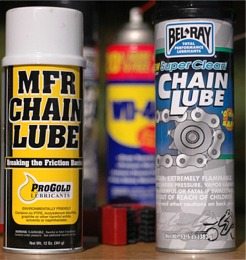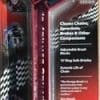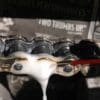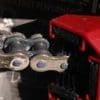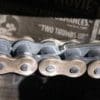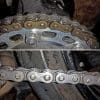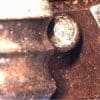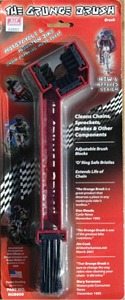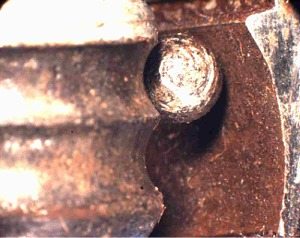Non-sticky, clear chain lube.
Leaves no residue, which may help prevent the buildup of grit.
Claimed to work on both O-ring and non- O-ring motorcycle chains.
Choosing a motorcycle chain lube is a controversial subject.
It’s right up there with the continuing controversies about motor oil and motorcycle tires.
Everyone has their favorite, and loads of B.S., urban myth and good old fashioned ignorance obscure the truth.
Until there is scientific proof that one motorcycle chain lube lasts longer, works better or reduces friction more than the others, we’re stuck with opinion rather than fact.
Owners of shaft-driven motorcycles have their own set of issues to deal with. The perception is that shaft drive means no maintenance, but this has only recently become true with BMW’s R1200GS.
Most shaft drive bikes do require regularly scheduled maintenance.
Maybe not as frequently as a chain lube, but spending 6 hours tearing a shaft drive apart to spread 10 pennies worth of Moly lube on a spline with a toothbrush is not my idea of fun.
Belt driven motorcycles seem to be the way to go; the belt drive systems are light weight, quiet and clean. But the motorcycle manufacturers seem to be very reluctant to adopt belt drive, for some reason.
So motorcycle chain maintenance procedures will continue to be important in the foreseeable future.
Much has been written on the subject, and we won’t rehash the details here, but suffice it to say that a chain should be cleaned and lubricated about every 200 miles or so.
Some of the newer motorcycle swingarm designs make changing a chain a very laborious process, so it pays to keep the chain clean and lubricated to help make it last as long as possible.
Oh — and don’t forget that the correct chain adjustment is also crucial to the longevity of your motorcycle’s chain.
I have my own routine that seems to work well. I won’t say that it’s better or worse than anyone else’s chain lubrication method, but I’m lazy, and this is about the easiest method I’ve found that seems to do a decent job.
When the chain is ready for maintenance, I’ll wait until the next time I go for a ride and when I return, I’ll park the bike over an old piece of vinyl flooring that I keep in the garage.
This helps prevent any of the solvents and lubes from staining the garage floor. The chain should be warmed up for cleaning and for the optimal distribution of the chain lube.
I suppose a chain lube could be performed in an emergency without a center stand, but it’s much easier to have the bike perfectly vertical with the rear wheel free to rotate.
If your bike doesn’t have a center stand, use a paddock stand on the swingarm to hike up the rear wheel.
We’ve been using the Steel Horse swingarm (paddock) stand in the webBikeWorld garage for a couple of years, and it works great (see the wBW review of the Steel Horse swingarm stand) and keeps the bike very secure during maintenance.
Cleaning the Chain
Note: See the update article on cleaning a motorcycle chain with Motul Chain Clean, Motorex Chain Clean 611 and kerosene).
I usually take some old newspaper (broadsheet, if possible) and lay it up in back of the chain, protecting the wheel and the frame from spray and dirt. The usual recommendation is to first clean the chain, using a degreaser or Kerosene.
It’s claimed that the absolute best way to get the chain clean is to remove it from the bike and soak it in Kerosene, but since most chains use semi-permanent master links, removing the chain is pretty much out of the question.
The blocks holding the bristles on the Grunge Brush can be adjusted to fit various chain widths.
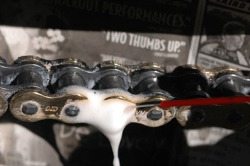
Everyone seems to have a favorite method of cleaning their chain.
Besides Kerosene, some recommend using a degreaser or even soap and water.
I use use WD-40 as my cleaning agent because it seems to do a good job, it can be sprayed on to the links with a decent amount of pressure, and it displaces water.
I must caution you that the use of WD-40 for cleaning motorcycle chains is controversial; some say that it will degrade the lubrication that’s sealed behind the O-rings of the chain at the factory.
It’s hard to know whether this is fact or fiction without some scientific evidence.
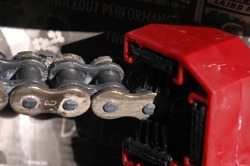
But it sure seems to me that WD-40 must be better than a degreaser, which by its nature is designed to remove grease. I honestly don’t think that the WD-40 gets past the O-rings.
If the O-rings are that bad, the chain is probably near the end of its life anyway. UPDATE: See below for more information on using WD-40 on chains!
Do some searching and you’ll find that there aren’t anywhere near as many motorcycle chain cleaners available as there are motorcycle chain lubricants.
As we were researching this article, we discovered that some motorcyclists use one of the thin-formula chain lube as a cleaner; more on that later.
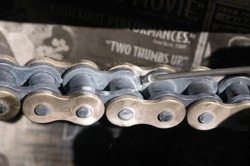
We recently found a chain cleaner: Motorex Chain Clean.
It’s claimed to be safe for O-ring chains. See the wBWquick review of this product and the recent wBW article “Chain Cleaner Redux: Motul vs. Motorex”
Back to the chain lube:
If I’m really in a rush, I’ll rotate the rear wheel and clean small sections of the chain by spraying on the WD-40 and wiping the chain down with some paper towels, then spraying on a quick coating of chain lube.
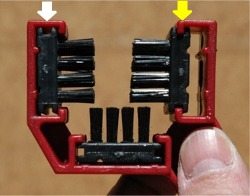
But to really clean out the dirt and caked-on chain lube, more aggressive action is required.
The Grunge Brush (photo above) works great to clean the grit and caked-on grease from the dirty chain.
An old stiff-bristled paint brush could probably be used, but the orientation of the bristles on the Grunge Brush are specifically designed to work with motorcycle chains, and the bristles are hefty enough to probably last a long time.
The bristles on the Grunge Brush are located on individual pads, which can be oriented on the handle to fit any type of motorcycle chain.
The photo (left) shows how the bristle pads can be located on the tool. The bristle pads are available as a replacement kit in case they wear out.
The Grunge Brush makes it easy to clean in and around all four sides of the chain. The combination of WD-40 and the Grunge Brush does a pretty decent job of cleaning up about 95% of the grime.
[Note: See the comment from “R.S.” in the Comments section below regarding the use of WD-40 as a chain lube.]It’s best to work on small sections of chain at a time. Slowly turn the rear wheel to present each section for cleaning. Use a mark or feature on the swingarm as a guide for where to align each section, and make sure there’s a bit of overlap.
This helps to ensure that the entire length of the chain will be cleaned.
After I’m done with the initial chain cleaning, I usually take a few sheets of paper towel and wipe down the chain, then re-clean any sections that are still dirty.
Another drawback of using WD-40 is that any remaining liquid may interfere with the lubrication properties of the chain lube. But this is always a problem no matter what type of solvent is used to clean the chain.
The other problem is that the WD-40 soaked newspaper is not environmentally friendly.
Make sure you at least don’t drip any WD-40 or any other solvent (or chain lube) on the ground. If anyone knows of a solvent that is more environmentally friendly method of cleaning a motorcycle chain, please let us know and we’ll also add the information to this article.
Motorcycle Chain Lube Types
There are many different types of chain lube, and everyone seems to have a favorite. Motorcycle chain lube is available in two types of formulations: thick and sticky or thin and watery.
One would think that eventually a single ideal type of chain lube formula would evolve, but each new product that comes to market is different than the rest.
Who knows how much of it is simply marketing hype, where the manufacturer feels that they must come up with something that looks different just so they can say that it is different?
I’ve been in the “thick ‘n sticky” camp for the last few years. My favorite was Bel-Ray Super Clean Chain Lube, which is one of the thicker formulations. It leaves a white residue that looks something like a white lithium grease.
I liked it because it resists flinging off the chain, although it does leave a fine dusting of white sprinkles all over the chain guard and frame during the fist few miles of use.
It has a tacky feel, which I thought was important, but I’ve since found that it is sticky enough to allow grit and dirt to cling to the chain, and this has me wondering whether the grit will increase chain wear.
It’s also so thick that I’m not sure that it really gets into the chain’s links, even when the chain is warmed up.
It seemed logical that a sticky chain lube is necessary to keep the lubrication on the chain.
I’ve tried one or two of the thin-formula lubes in the past, but once you’re used to seeing a nice, thick coating all over the chain, it’s hard to get used to seeing the thin-formula lube drip right off and leave the chain looking unprotected.
So it becomes a matter of faith that the chain lube manufacturer knows what they’re doing and that their product really does meet all their claims.
However, we discovered an interesting use of the thin-formula type of chain lube.
To get around the problem of what to use as a chain cleaner without removing the grease behind the O-rings, apparently some motorcyclists use the chain lube itself as a cleaner, rather than WD-40, Kerosene or degreaser.
This could be something to consider, although after trying it, we found that the chain lube doesn’t do a very good job of removing grease and dirt.
ProGold MFR Motorcycle Chain Lube
The impetus for this article was a recent contact with ProGold Lubricants, who sent us a couple of cans of MFR Chain Lube to try. MFR is one of the “thin and watery” type of formulas.
MFR stands for “metal friction reducer”, and the manufacturer claims that the product is specifically formulated for use on motorcycle chains.
ProGold claims the MFR Chain Lube “carries MFR molecules to critical chain points, treating the metal itself to provide an exceptionally strong, wear-resistant surface”.
We weren’t familiar with the ProGold product line, so we did some research and found out that MFR Chain Lube seems to be one of these well-kept secrets of motorcycling.
Apparently, the product is especially popular with off-road motorcycle riders because it isn’t sticky, which helps prevent dirt from accumulating on the chain.
ProGold claims that the “thin-bodied” formula “eliminates the need for thick, tacky lubricants, minimizing the problem of dirt and abrasives sticking to the chain”.
Indeed, the formula is very “thin bodied”, with a consistency similar to WD-40. This makes it work as both a chain lubricant and a decent chain cleaner.
The ProGold representative also made a very interesting claim. He said “What if I could promise that a conventional chain would last longer than an O-ring (chain) and you won’t have to clean it anymore?
Not only would the chain cost less, but it would not steal horsepower. That is exactly what MFR Chain Lube will do for you! That’s why you won’t have to buy O-ring chains anymore!”.
Of course, most motorcycle chains used on street bikes use the O-rings or X-rings (an O-ring with an “X” shaped cross-section), so the rep’s claim may be a moot point.
So I took the plunge and I’ve been using the MFR Chain Lube recently. ProGold recommends cleaning all other chain lubricants from the chain before using MFR, which is rather hard to do.
To clean off the old lubricant, you’d have to use a degreaser or WD-40.
If you do that, you now have degreaser on the chain rather than lubricant. Perhaps it would be best to start using MFR with a brand-new chain, but even new chains are covered in grease.
After using MFR a few times, most of the old lubricant is gone from the surface of the chain anyway.
Using MFR Chain Lube takes a leap of faith if you’ve been using one of the thicker, sticky chain lubes. The product is clear and has very little odor. It leaves no apparent residue on the chain, so it’s not easy to tell if it’s been applied.
In fact, the chain looks clean, dry and un-lubricated after the MFR has been applied.
Let me reiterate that without a scientific test, it will be impossible to tell whether or not MFR Chain Lube works better or worse than any other type of chain lube.
But I’ll continue to use it and report back if I notice anything unusual.
In the meantime, my chain does seem to stay cleaner than it did in the past, probably because there is no sticky residue on the chain for the road grime that would act as an attractor for road grime.
Owner Comments and Feedback
See details on submitting comments.
See the wBW article “Motorcycle Chain Cleaners Redux” for many comments on lubricating motorcycle chains.
From “T.M.” (August 2015): “If you’ve ever used WD-40 on a cycle chain you’ll know why it’s not recommended for cleaning chains. After cleaning and re-lubricating, the chain runs like its been doused in grit.
WD-40 is a penetrating oil. It forces its way , along with any dirt , past any seals and O-rings. Its actually driving grit INTO the rollers of the chain. Stay away from it, even if the result does look good.”
From “M.L.” (August 2015): “Halfords recommend GT-85 for bike chains. Smells good and has done a great job on my Shadow ACE chain which I could hardly see for gunge when I bought it.
Don’t know about chemical content, think it contains PTFE, but it is in a spray can. With that and a tooth brush (an old one) it came really clean.”
From “B.K.” (August 2013): “I just read an article on chain cleaning with two products compared to typical kerosene. The bit about the WD-40 was helpful as I planned on using that to clean my chain.
Any who, I just used soap, water, and a brush to clean my motorcycle chain. I used just an auto soap that I use to wash my motorcycle and car with.
I went with this as to that is the job of the soap is that the soap molecules surround the dirt and oil molecules and then the water washes the soap surrounded dirt/oil molecules away.
I have attached pictures (below) that show the before and after. The chain was excessively dirty. Granted it’s not spotless but I had to stop for the night due to it getting dark and the garage being occupied with other projects.
Would you recommend letting it soak in kerosene? I’ve even heard of using lighter fluid as a cleaning/soaking agent.
(Cleaning a chain with soap and water) should be done if nothing else is available, due to it being time-consuming and (you) will need to dry off the chain thoroughly then apply plenty of chain lube or wax, whichever one you prefer.
Is there one that is superior, wax or lube, to the other one. I’ve only ever used wax so I don’t know how it compares to lube. I’ve heard mixed things, I’d just like to hear your guys’ input.”
Editor’s Reply: It may be more important to keep the chain clean than it is to keep it lubed; modern motorcycle chains have excellent internal lubrication.
A “dry” chain lube is best — one that does not leave a sticky residue that will attract dirt and grit. We have reviewed many different lubes and a couple of our favorites are listed in the Motorcycle Chain Lube Comparison.
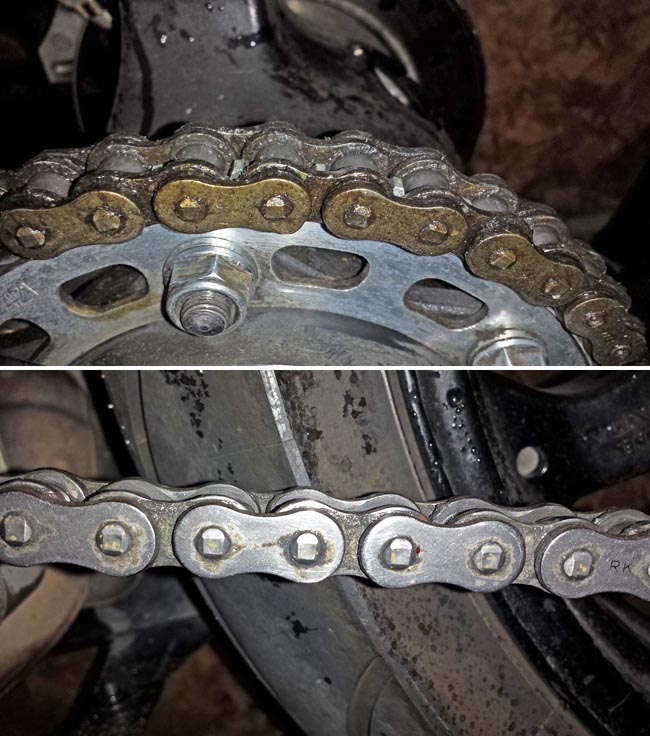

From “G.F.” (November 2012): “I clean the chain with a soft tooth brush and diesel fuel. Hold a clean rag around chain and rotate tire slowly to wipe off excess diesel.
Will be clean to the touch and no fling and being dry will not attract grime. Oil in diesel fuel will soak O-rings and lube for 500 miles.
Have not needed to adjust chain all summer. You need to do this every 500 miles or when chain gets wet. Not a big job, maybe 15 minutes.”
Editor’s Reply: Diesel fuel has additives that may harm the O-rings, I’d suggest kerosene instead for cleaning. Diesel and kerosene are not very good lubricants for motorcycle chains however.
From “G.”: “Finish Line Ecotech Degreaser came with the Grunge Brush I bought. It certainly does the job, but whether or not it gets behind the O-rings? I don’t know.
The concentrate will make plenty. I just filled a spray bottle, and sprayed the chain as I spun the rear wheel, then scrubbed with the grunge brush. Rinsed it, wiped it off with a rag, then applied my lube of choice.
I used the Finish Line Degreaser until it was gone, and just went back to a rag soaked with some good ol’ kerosene.”
From “S.M.”: “Just read your great review of the Kettenmax Chain Cleaner. It’s an interesting rig, but I’m of the same opinion that it’s just as simple and easier to spray on the WD-40 and wipe the thing off with towels/rags.
Anyway, the WD-40 thing has been argued for as long as I’ve been participating in online enthusiast forums. If you have a moment, I recommend the following on the Yamaha FZ1 forum.
(The article) contains a response from WD-40 as well as from a chain manufacturer (Tsubaki) in regards to the use of the stuff for cleaning chains.”
Another interesting story, this one shows what happens to O-rings after soaking in a variety of cleaning fluids.
From “R.S.” sent us some interesting information on the use of WD-40 on motorcycle chains:
“Saw your article on using WD-40 for chains and you asked for evidence of potential harm that WD-40 can do, so am attaching a photo. This photo is of a bearing surface from an airplane.
This is a ball and races in a sealed bearing that had been subjected to regular use of WD-40 for a year or two.
The grease was NOT cleaned out before taking this photo – there simply is no grease and the brownish tint is really rust.
The ball had grooves (visible) and was shaped like a potato chip. The races had not evenly worn (see sectioned edge) and were rutted in spots, although neither shows too well.
We learned that WD-40 is really good for the light uses that it was intended for and that needs to be emphasized. However, it is largely a penetrant, which will do just that!
Once it penetrates into the sealed area, it dissolves the petroleum out of the grease, leaving the clay binders.
What’s left in the bearing is essentially dirt that cakes up, causing the balls to skid. Without the petroleum, the bearing will also rust.
The reason that kerosene and diesel fuel are still favorites and recommended by the chain people is that while both can be penetrants, they are a thicker petroleum and just what the O-rings are trying to seal against.
Of course, gasoline cleans about the same, but with thinner viscosity and better penetrating power.
In all honesty, I still use gas to clean (I’m lazy), but don’t beat the bike often, regularly measure for linkage stretch and sprocket wear, and re-lube on every other tank of gas.”
Moral of the story is to not use WD-40 for cleaning motorcycle chains.
Does anyone know of a better product that is specifically designed for cleaning a motorcycle chain without dissolving the grease behind the O-rings?
NOTE: See the wBW article “Motorcycle Chain Cleaners Redux” for many comments on the WD-40 issue and lubricating motorcycle chains.


